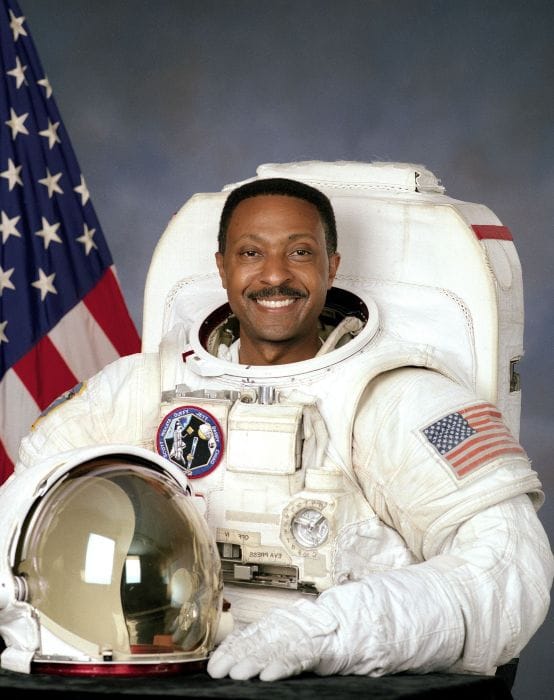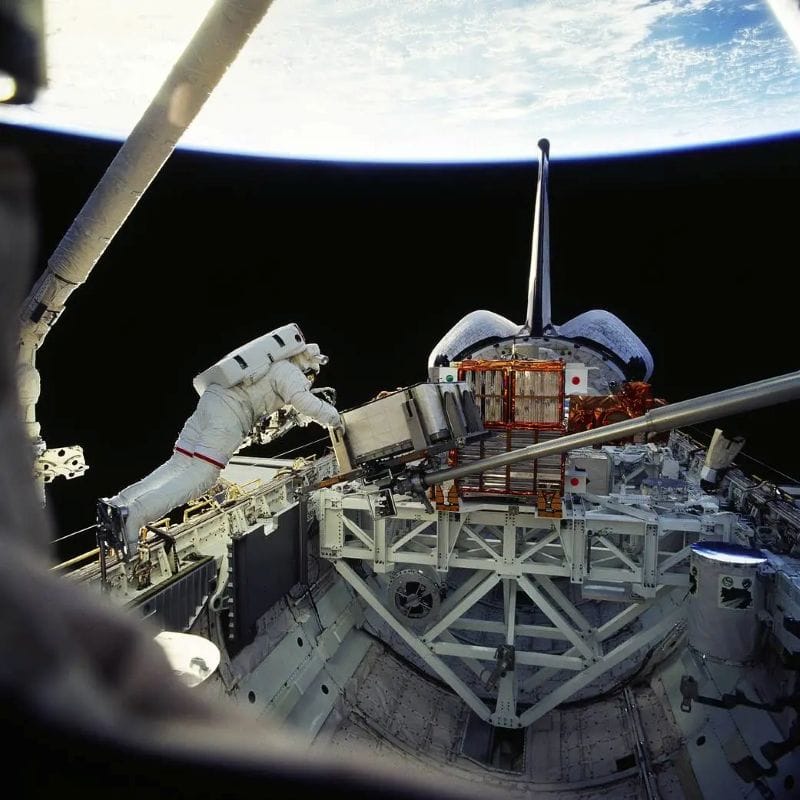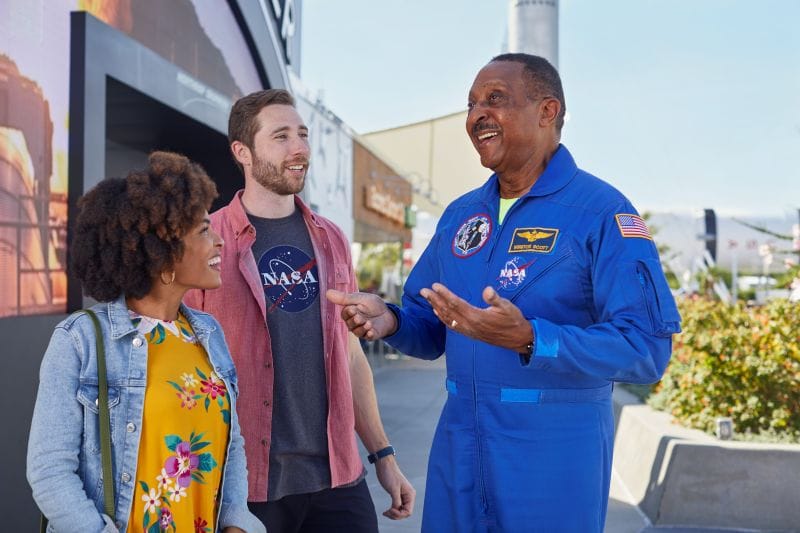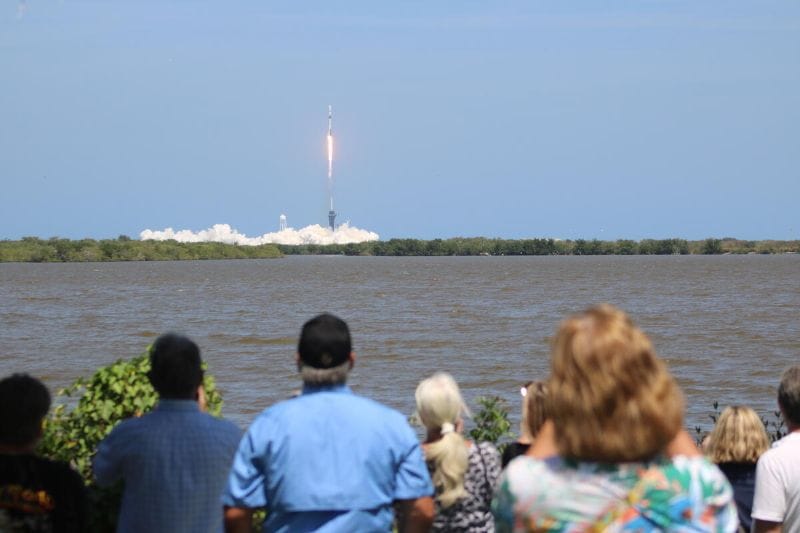Summer Bucket List: Go See a Rocket Launch at the Kennedy Space Center Visitor Complex
If you haven’t had a chance to experience a rocket launch in person, this is the summer to make it happen!
While we can see the faint glow of a launch from here in Central Florida, there is nothing like seeing it up close, especially from the Kennedy Space Center Visitor Complex. I took my boys, and it was one of the most memorable experiences for us as a family. We loved it so much that my oldest returned for summer day camp at the Kennedy Space Center.

In Case You’re Interested:
>> Super Fun Family Restaurants
>> Cheap Family Fun
>> Orlando Hotels with Waterparks
But don’t take it from me—how about a real astronaut?
We recently met up with astronaut Winston Scott to talk about the ways you can experience the wonders of space at the Kennedy Space Center Visitor Complex with the kids, and I promise, it is well worth the drive and definitely doable as a day trip.
🚀Did you know?? Winston Scott logged 24 days in space during two missions to space, including three spacewalks totaling more than 19 hours.

The Kennedy Space Center is a unique attraction. It’s not a theme park and better than a museum—it’s a pretty incredible place.
Winston Scott: The Kennedy Center Visitor Complex is a place where a person can immerse themselves in the space program, and you really feel it. There’s just so much to do and so much to see, it really makes a significant impact on all who visit.
They can not only meet people who’ve flown in space, but they can also see the real hardware. You can get up close and personal to the Atlantis space shuttle that actually flew in space. And you can also visit the Apollo Saturn V Center.
You stand right underneath the Saturn V rocket. This rocket was a real rocket scheduled to go to the moon before the Apollo program was canceled.
You can touch a moon rock. There are so many activities that you can experience. You immerse yourself in the past, the present, and a little bit of the future of our space program.
Tell us about the daily Meet the Astronaut program, which you coordinate.
Winston Scott: We have several programs that the astronauts will perform. One is called Astronaut Encounter, and it’s in a large auditorium. The person will give a presentation, and they do Q &A. Then we have a program called “Chat with an Astronaut,” which is kind of like a fireside chat.
It’s a small group of people in the audience. You can ask that person anything you ever wanted to ask about flying in space. It is important, especially to young people, because when they meet people who have actually flown in space, it becomes a reality to them.
Imagine a young girl, six or seven years old, meeting a real woman who actually flew in space. Now it’s real.

TBPM: Why would you encourage families to go and experience a launch together?
Winston Scott: It is so monumental and so influential. Seeing a rocket launch, I think, affects everybody in one way or another. But I think it would have a special impact on young people. When you’re up close and personal to see one, that’s a whole different dimension. And when you see a launch that has people on it, that really is the ultimate.
It’s something everybody in the world will see at least one time. Again, because it’s still a very, very unusual occurrence, and it represents the efforts of so many people who come together to work so hard to make this amazing thing happen.
There’s a new attraction opening at the Kennedy Space Center called The Gantry. What can you tell us about it?
Winston Scott: Launch Complex 39 is being refurbished into a Gantry. You’ll be able to see the launch pads, you’ll be able to see the crawler tracks, the equipment, and you’ll be able to watch launches from there.
So, we have to know…what does it feel like to be weightless in space, especially while on a spacewalk!
Winston Scott: Feeling weightless is just so foreign, and there are no words I can say to make you feel it. When you’re on a spacewalk, it’s just you and your buddy out there. Nobody can help you. Nobody can go out and get you if something goes wrong.
So, the two of you are there to get the job done, but you’re also there for mutual support in case something goes wrong. So you’ve got to really be able to compartmentalize, focus on what you’re doing while you’re in this absolutely amazing and foreign environment.
Flying in space changes your life perspective. You look back at the Earth from that vantage point and see how small it is, how fragile it looks, because when you’re in space, not only do you see the curvature of the Earth, the boundary horizon, but you see out past the Earth. You can see other planets, other stars, and so on.
So you realize the Earth is really a relatively small, finite piece of rock in the universe. It gives you a whole other perspective.
You don’t see boundaries from one country to another, one group of people to another, and you see no turmoil. It’s very, very peaceful and quiet looking. Really beautiful.

For the kids out there who are aspiring to become a part of the space program, what’s your advice?
Winston Scott: I think parents ought to encourage all kids, and people of all ages ought to encourage each other to come and do this because it represents the future. The future of humankind is beyond Earth.
Humankind is, if we’re going to survive, it’s out past our own solar system, our own universe, but living outside of our Earth. But also, it expands our horizons, it expands our thinking, and it brings us together internationally.
You know, everything we do in space nowadays is international. It broadens us, it helps us grow, it just improves us as individuals in so many ways, and improves us as a human species in so many ways.
And it’s just downright fun. Watching a rocket launch is fun.
What can we as parents teach our children to help them achieve their dreams, even if they don’t want to fly to space?
Winston Scott: Resilience is so important, and that’s where parents come in. Parents should do what they can to instill that resilience in their children.
You teach them from day one to work hard to persevere, and when things don’t work out your way, you don’t give up. You get up, and the old saying goes, you get up and you try, try again. I don’t use the word fail.
Having a setback is not the end of the world; it’s just a stumbling block to overcome. And every time you overcome a stumbling block, it makes you stronger, it makes you better. In fact, we learn more from our failures or our difficulties than we do from our successes.
How to See a Rocket Launch at the Kennedy Space Center
Visit the Launches and Events page on kennedyspacecenter.com to check the updated calendar. You can sign up for email notifications when ticket packages become available.
Launch viewing locations at the Kennedy Space Center Visitor Complex:
- Feel the Heat Launch Viewing Package at the Apollo/Saturn V Center: This is the closest you can get to the launch sites. Tickets are typically $250.
- Main Visitor Complex: You can watch from the Atlantis North Lawn or the Atlantis South Lot, where they have large screens and bleachers set up for viewing (this is what we did). You will want to purchase your admission ticket for the launch day in advance because launch day tickets do sell out.

Notable Upcoming Events:
Moon Fest 2025: July 18-20: Celebrate the 56th anniversary of the Apollo 11 moon landing with a weekend filled with immersive experiences, vintage photo ops, live music, activities, Apollo and Artemis presentations,and more!
Kennedy Under the Stars: Aug 30: This after-hours experience at Kennedy Space Center Visitor Complex features glow-in-the-dark mini golf, dance parties, astronaut meet-and-greets, and more!
For even more events and astronaut meet and greet info, explore kennedyspacecenter.com.
Originally published in the Jul/Aug issue of Orlando Parenting Magazine.

